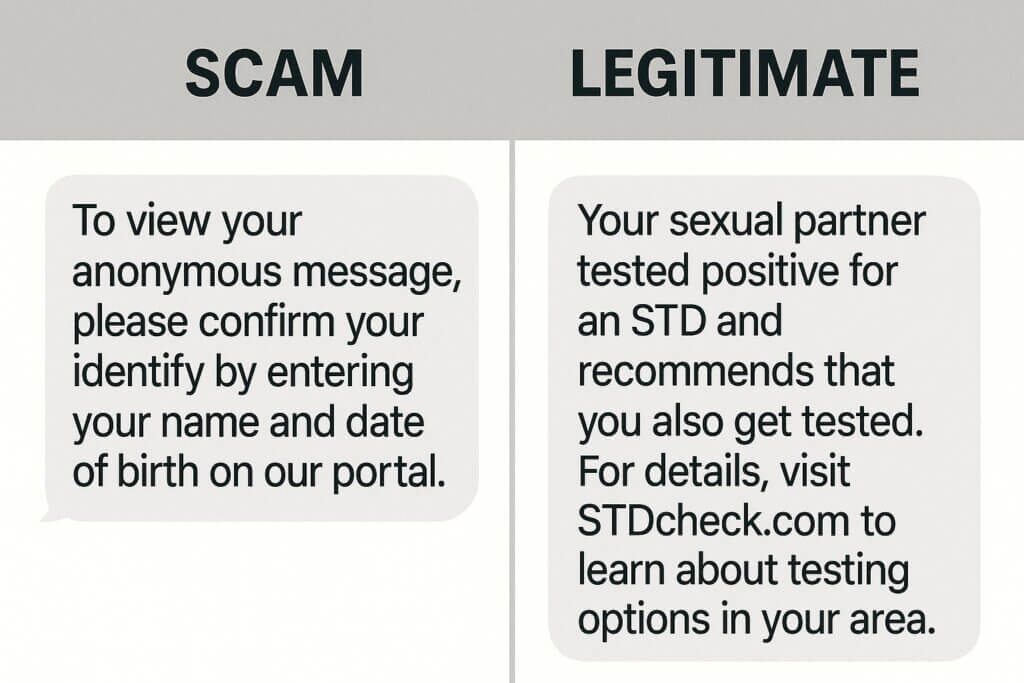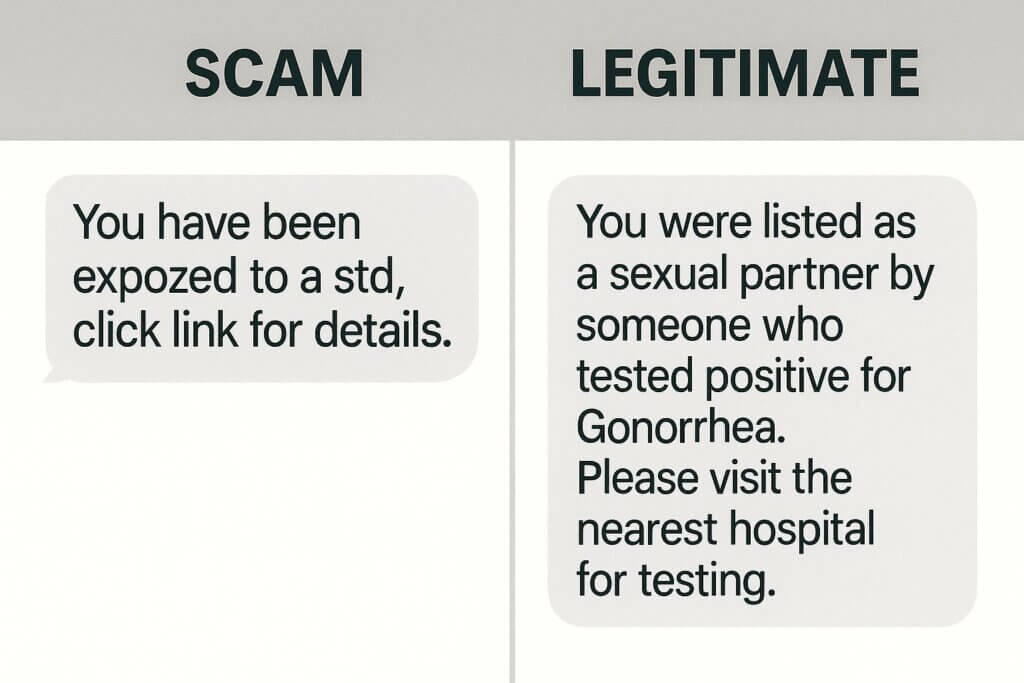It can be really unsettling to get an unexpected message about your health status, especially if the message has anything to do with an STD. You will naturally feel anxious or even panic a little. But before you click any link or respond to the message, take a moment to evaluate what you have received.
Without a lie, not every message like this is genuine. Some are pranks from friends, while others are outright scams designed to trick you. Therefore, it is important that you know how to tell the difference between a fake anonymous STD notification and a real one.
In this article, we’ll help you with that. You’ll learn how to verify the legitimacy of an anonymous STD alert and steps to take if you’re not sure if the text is legit. Knowing what to look for in an anonymous STD alert can help you protect your privacy, your health, and your peace of mind.
The 3 Possibilities: Scam, Prank, or Legitimate Alert?
When you receive an STD notification text, know that you’re facing one of 3 possibilities. No matter how believable the text looks, consider these 3 possibilities before taking action.
- A Dangerous Scam: This is a phishing attempt designed to steal your personal information, install malware into your device, or trick you into paying for something. Naturally, everyone is more worried and tends to act impulsively when their health is threatened, so cybercriminals take advantage of this to plot scams. These scams often lead to insecure privacy, financial fraud, and device compromise.
- A Cruel Prank: This is a fake STD text message prank where someone uses a legitimate anonymous notification service (like TellYourPartner) to harass, embarrass, or scare you. While the service is real and used for legitimate health notifications, the intent behind the particular message sent to you is malicious.
- A Legitimate Alert: This is when a former or current partner uses an official notification service to responsibly and anonymously inform you of potential STD exposure. Unlike the two possibilities above, this is the real purpose for partner notification services. It plays a crucial role in helping people get tested and treated when they may not know about their exposure risk.
5 Ways to Identify Fake STD Text Messages (with Examples)
Below, we’ve outlined how to identify a fake text message with examples. When you notice that the message has any of the facts mentioned, beware.
- Extreme Urgency & Emotional Manipulation: Scams prey on fear, and use phrases that will make you panic and act without thinking. They try to convince you to take action; otherwise, your health status will be revealed to the world.
- Scam Example: “URGENT: You have been exposed to HIV! Click HERE to see your test results NOW or your data will be public!”
- Legitimate Example: “Someone who has tested positive for HIV has listed you as a partner. To learn more and find testing centers around you, visit cdc.gov/sti/.”

Legitimate STD text messages are usually calmer and contain information about how you can get tested & treated.
- Requests for Personal Information or Payment: Legitimate notification services will never ask for your password, social security number, or credit card details via text before you can see the notification. They are designed for privacy protection, not collection of personal data.
- Scam Example: “To view your anonymous message, please confirm your identity by entering your name and date of birth on our portal.”
- Legitimate Example: “Your sexual partner tested positive for an STD and recommends that you also get tested. For details, visit STDcheck.com to learn about testing options in your area.”

While legitimate notification services might ask you to create an account, the process is guaranteed to be secure and encrypted.
- Grammar and Spelling Errors: Poor grammar and spelling mistakes are classic signs of fake spam text examples, which is an indication that the message is from a scammer or an automated system.
- Scam Example: “You have been expozed to a std, click link for details.”
- Legitimate Example: “You were listed as a sexual partner by someone who tested positive for Gonorrhea. Please visit the nearest hospital for testing.”

True STD notification providers use correct grammar and ensure there are no spelling mistakes since they are dealing with sensitive health information.
- Promises to Reveal the Sender’s Identity: This is a spam text example that exploits human curiosity to know who the sender is. Legitimate anonymous services are built on privacy. They will never offer to reveal who sent the message.
- Scam Example: “Find out which of your partners gave you an STD. Click here to reveal their name.”
- Legitimate Example: “Your sexual partner asks to alert you of a possible exposure to an STD. We recommend you get an immediate test to verify, as the person’s identity cannot be revealed.”

The entire purpose of anonymous notification services is to protect people’s privacy while still facilitating important health communication.
- Unexpected Attachments or Download Prompts: A legit notification service will direct you to a webpage for more information. It will not ask you to download a PDF, .apk, or .exe file.
- Scam Example: “A sexual partner of yours says you may have an STD. Download the attached PDF to view the STD diagnosis.”
- Legitimate Example: “There’s a report that you may have contracted an STD. Please visit your healthcare provider for testing.”

The unexpected attachments and downloads usually contain malware designed to infiltrate your device or steal personal information.
6 Rules to Verify a STD Text Message Safely
Follow these important rules to protect yourself while determining if a STD text message is real or fake:
- DO NOT Click the Link: Assume the link is malicious until proven otherwise. This is a safe way to protect your privacy against immediate harm.
- Open a New, Secure Browser Window: Instead of clicking the link, go to the browser on your computer or phone and open a new, secure browser window.
- Manually Type the Website Address: For example, if the URL is anonsms.com, type www.anonsms.com directly into the new browser window’s address bar. Do not copy and paste the link.
- Check the Official Website: Assess the website and verify if it looks professional. Does it explain the service offered? A legitimate website will contain comprehensive information like “Our Services,” “About Us,” “FAQs,” and contact information. A scam site is often a single, simple page with small content.
- Use WHOIS to Query Domain Information: Check the domain’s registration information and history at whois.net to determine the legitimacy of the website itself.
- Test the Website Functionality: Navigate through the website to understand how the service works. Real STD notification websites will have clear processes and transparent policies.
What If the Partner Notification Service is Real, but it’s a Prank?
As highlighted in the active discussion about spam STD notifications on Reddit, the partner notification website can sometimes be legitimate; however, it may be misused by someone for inappropriate purposes, such as playing a prank or harassing you. This is an abuse of the real purpose of why the service was created.
However, if you follow the verification steps above and confirm if the site is real, you can then examine the text thoroughly to know if it’s genuine or fake. As said earlier, you shouldn’t jump to conclusions. It may be a dangerous scam, a prank, or an anonymous message from someone who’s embarrassed to admit it.
Most legitimate websites have a way to “report harassment” or “remove your number” from their system, but it’s advisable that you think about this over and over again before taking action. While “harassment report” can be investigated, “number removal” might prevent you from receiving future, genuine notifications. Therefore, don’t act based on only today’s thought. Think about the possibility of getting a legitimate notification in the future.
When in Doubt about the STD Text, Your Health Comes First
Regardless of whether it’s a fake STD anonymous notification or a real one, the safest and most responsible course of action is the same — getting tested. Let’s be honest, the anxiety of not knowing what your current health status is can be worse than the reality. A test gives you peace of mind and control. It makes you know your next course of action whether to report the message for harassment or be in touch with your healthcare provider for required treatment.
We know it can be a lot at first and may be somewhat confusing. We’ve got you. No need to click any link to take care of your health. Just read our Complete Guide on Getting Tested for STDs and finding a clinic near you.
Perguntas frequentes
- Is TellYourPartner legit?
Yes, TellYourPartner is legit. It frowns against any form of harassment or embarrassment. The platform comes with a text template that ensures users don’t include unpleasant languages.
- Is TellYourPartner anonymous?
Yes, TellYourPartner is completely anonymous. It offers 100% privacy and ensures your identity is not exposed. The message will be untraceable to you.
- Is TellYourPartner a text prank?
No, TellYourPartner is not a text prank. In fact, the platform does not support any phrase or language that connotes pranking.
- Can I get a virus from clicking a link in a text?
Yes, your device can be infiltrated with virus or malware when the link is from a fake source.
- How to spot a phishing text message?
Check for signs like emotional manipulation, request for personal information or payment, grammar & spelling errors, promise to reveal sender’s identity, and file attachments or download prompts.
Considerações finais
Here are key notes in identifying a fake anonymous STD notification:
- Assume all unexpected health texts are scams until verified.
- NEVER click the link; always type the URL manually in a new browser window.
- Assess the website to verify its functionality and processes.
- Look for red flags like urgency, bad links, grammar errors, and requests for info.
- Whether it’s real or fake, the smartest move is to get a confidential health check-up.
For a complete overview of what to do after receiving an anonymous notification, from checking the tech to talking to partners, see our Ultimate Guide aqui.

 Anonsms
Anonsms
 TellYourPartner
TellYourPartner




